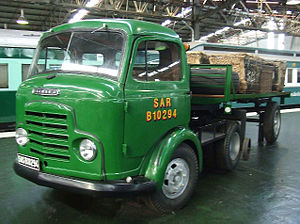Karrier
This article needs additional citations for verification. (December 2008) |

Karrier is a marque of car and commercial vehicle, the origins of which can be traced back to Clayton and Company, a 1904 company founded by Herbert and Reginald Clayton from Huddersfield, West Yorkshire, UK. In 1908, they started making Karrier cars and in 1920 changed the company name to Karrier Motors Ltd. It also produced buses and in latter years, especially during the Second World War, trolleybuses, notably the Karrier 'W' model.
Colt, Cob and Bantam
In 1929, Karrier started production of the "Colt" three-wheeler as a dustcart chassis for Huddersfield Corporation. In 1930, this was developed into the "Cob" tractor to haul road trailers for the London, Midland and Scottish Railway. The "Cob" was similar to the Scammell Mechanical Horse. In the mid-1930s, the "Cob" range was supplemented by the four-wheel "Bantam".
Takeovers and mergers
Rootes Group
After takeover bids in 1934, the Rootes Group acquired Karrier and moved production to Luton, closing the Huddersfield operation. In the late 1950s and 1960s, some Karrier vehicles were fitted with the iconic Rootes TS3 two-stroke opposed piston diesel engine. Other engines used in this period include Humber Hawk 4- cylinder petrol engines (L-Head and OHC), Humber Super Snipe 6-cylinder (L-Head and OHV) and Perkins Diesels.
At Luton, the only designs carried over from the previous era were the three wheeler and the six-wheel trolleybus chassis.
The trolleybus business became integrated with that of Sunbeam following its absorption into the Rootes group. In 1946 the trolleybus operations and the Wolverhampton trolleybus line was sold to Brockhouse Ltd, who in 1948 sold it to Guy Motors.
Under Rootes ownership, Karrier trucks were generally smaller size than their sister, Commer brand, with "Bantam" models using 13-inch and "Gamecock" models using 16-inch wheels, to give lower loading height. Partly because of this, they were particularly popular with local authorities for varied applications, including highway maintenance tippers, refuse collection vehicles and street lighting maintenance tower wagons. Karrier trucks and chassis were also popular with airport operators and airlines for baggage handling trucks, water bowsers and toilet servicing.
Dodge (UK)
The Dodge Brothers company came to the UK in 1922 and began importing United States Dodge knock-down kits to build in the UK at a production line in Park Royal, London. Eventually, production was moved to the Chrysler plant at Kew; Dodges built there were known as "Dodge Kews". During the Second World War this factory was part of London Aircraft Production Group and built Handley Page Halifax aircraft assemblies.
In 1965, production moved to Dunstable where Commer, Dodge (UK) and Karrier were all brought together.
Chrysler Europe
By 1970, the Rootes Group had been taken over (in stages) by Chrysler Europe, with support from the British Government which was desperate to support the ailing British motor industry. The Dodge brand (also used by Chrysler in the USA) began to take precedence on all commercial models. The last vestige of Karrier was probably in the Dodge 50 Series, which began life badged as a (Chrysler) Dodge but with a Karrier Motor Company VIN (vehicle identification number) plate.
Peugeot and Renault
Chrysler eventually gave up on UK operations, selling the business to Peugeot. The new owner had little interest in heavy trucks and the factory was then run in conjunction with Renault Véhicules Industriels, (then part of Renault though now Volvo). The combined company used the name Karrier Motors Ltd,[1] although the vehicles took on Renault badges and were sold through Renault Trucks dealers. Renault had been keen to secure a UK manufacturing operation for engines for its own models, and did relatively little to market or develop the British designs, favouring its existing French range such as the Renault Master. The end of the Karrier name could not be far off; eventually, Renault severed ties with Peugeot[citation needed] and introduced a Renault Truck Ind. or Renault Vehicles Ind. VIN plate (RVI).
The Karrier trademark is still in the possession of Peugeot, and it is not uncommon for vehicle marques to be reinstated.
Ro-Railer
Karrier's Ro-Railer was a hybrid single decker bus capable of running on both road and rail. It was introduced in 1932 and tested by the London, Midland and Scottish Railway but it was not a success and was not perpetuated.[2][3] One of the few operational bus rail systems is to be found in Adelaide (Australia) called the O-Bahn Busway.
Usage
References and notes
- ^ "Rootes-Chrysler resource site".
- ^ http://www.blisworth.org.uk/images/Rails-three.htm
- ^ New Scientist Dec 23-30, 1982
- ^ Dunbar, Chas (1968). Buses, Trolleys and Trams. Hamlyn Publishing Group. p. 81.
